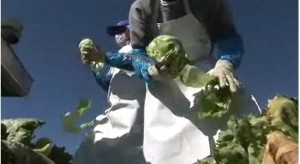From July to Oct. 2010, 136 people in London and east England were sickened by Salmonella Java phage type 3b variant 9. Gobin et al., from the U.K. Health Protection Agency, report in Eurosurveillance today that most cases were female with a median age of 39.5 years and lived in London. Results of epidemiological investigations are compatible with salad vegetables as the potential source, but no common suppliers of salad were identified and no organisms were isolated from environmental and food samples.
S. Java is present in poultry flocks in the European Union and is the most common serovar reported in poultry in the Netherlands. Outbreaks of S. Java have been reported in the past, associated with salad vegetables, goat’s milk cheese, poultry, reptiles and tropical fish .jpg) aquariums. S. Java is an uncommon cause of salmonellosis in the United Kingdom (UK), with 151, 112 and 130 cases reported in 2007, 2008 and 2009 respectively according to the national database.
aquariums. S. Java is an uncommon cause of salmonellosis in the United Kingdom (UK), with 151, 112 and 130 cases reported in 2007, 2008 and 2009 respectively according to the national database.
In 2007, a multi-country outbreak of S. Java phage type (PT) 3b variant 9 (var9) involved cases in Denmark, Finland, the Netherlands, Norway, the UK and the U.S. Epidemiological evidence suggested an association with salad vegetables.
The results of the case–case study confirmed a significant association between symptomatic infection of S. Java PT 3b var9 and eating out at restaurants, eating pre-packaged mixed salad leaves at home, consumption of salad leaves from takeaway restaurants and eating any salad leaves either at home or purchased from commercial catering settings. Since salad is often used as a garnish in meals eaten in commercial catering settings, it is possible that the model underestimated the proportion of cases who consumed salad leaves away from home.
We cannot exclude the possibility that the study may have missed the right vehicle of the outbreak such as sprouted seeds which have been implicated in two recent outbreaks in Europe. It is likely that the consumption of smaller food items (seeds, sprouted seeds and herbs) in salads prepared by commercial caterers was not remembered or was not noticed by cases. None of the smaller salad items were found to be associated with cases during the hypothesis generation. It is possible that salad leaves were a confounding factor in this investigation and smaller, less memorable items should be considered in outbreaks where salad vegetables appear to be implicated.
Environmental investigations did not identify common suppliers of salad vegetables and the short shelf life of salad vegetables limited the ability to acquire any suspect foods for microbiological analysis.
The contamination of salad leaves and salad vegetables during their production and processing has been implicated in a number of geographically widespread outbreaks. High risk practices during production and processing include the use of contaminated water either to irrigate the crops, to apply pesticides or other dressings, or to wash the crop once harvested; the use of human or animal sewage as a crop fertilizer; and the transport of the harvested crop in a contaminated vehicle/storage system, e.g. trucks previously used for transporting waste. Crops growing in the field are also vulnerable to contamination from sources such as wild animals and birds
Gastrointestinal infection associated with salad vegetables may also be the result of cross-contamination from poultry, meat or meat products or contamination by the food handler during food preparation in the home or in catering establishments. A review of more than 2,000 general .jpg) foodborne outbreaks from 1992 to 2006 undertaken by the HPA found that 4% of them were associated with prepared salads. The review found that most of the outbreaks linked to salads occurred in the catering sector and were associated with infected food handlers, cross-contamination and poor storage.
foodborne outbreaks from 1992 to 2006 undertaken by the HPA found that 4% of them were associated with prepared salads. The review found that most of the outbreaks linked to salads occurred in the catering sector and were associated with infected food handlers, cross-contamination and poor storage.
The increase in illness and outbreaks associated with the consumption of fresh ready to eat salad vegetables indicates the ongoing need to improve methods in the production and preparation of these foods to reduce the potential for contamination with Salmonella and other enteric pathogens.
The complete epidemiological write-up, with a full discussion of limitations, is available at http://www.eurosurveillance.org/ViewArticle.aspx?ArticleId=20023.
 Tonight Sorenne-the-Ravenous only wanted to eat a sandwich, but after too many frozen chicken thingies and wondering why Australians don’t say whether the chicken is pre-cooked or raw, I needed some real food. Broiled porterhouse steak cooked to an internal temperature of 150F and left to rest while the temperature rose slightly, rosemary and sea salt chips, English cucumber and 4 leaf salad with cherry tomatoes, balsamic and olive oil. Yum. But a lonely dinner for one.
Tonight Sorenne-the-Ravenous only wanted to eat a sandwich, but after too many frozen chicken thingies and wondering why Australians don’t say whether the chicken is pre-cooked or raw, I needed some real food. Broiled porterhouse steak cooked to an internal temperature of 150F and left to rest while the temperature rose slightly, rosemary and sea salt chips, English cucumber and 4 leaf salad with cherry tomatoes, balsamic and olive oil. Yum. But a lonely dinner for one.






 Approximately 30 domestic cases are reported annually (2010 incidence rate 0.5 cases/100,000 population). In Norway, >98% of cases of Yersinia enterocolitica infection are caused by serotype O:3, which is also the dominant serotype in Europe, Japan, and parts of North America. Infection by Y. enterocolitica is often associated with ingestion of pork because pigs commonly harbor the pathogenic serotypes O:3 and O:9. Recent foodborne outbreaks have been associated with pork products (2,3) and pasteurized milk.
Approximately 30 domestic cases are reported annually (2010 incidence rate 0.5 cases/100,000 population). In Norway, >98% of cases of Yersinia enterocolitica infection are caused by serotype O:3, which is also the dominant serotype in Europe, Japan, and parts of North America. Infection by Y. enterocolitica is often associated with ingestion of pork because pigs commonly harbor the pathogenic serotypes O:3 and O:9. Recent foodborne outbreaks have been associated with pork products (2,3) and pasteurized milk. eating a salad,” the Interfax news agency reported Thursday.
eating a salad,” the Interfax news agency reported Thursday..jpg) aquariums. S. Java is an uncommon cause of salmonellosis in the United Kingdom (UK), with 151, 112 and 130 cases reported in 2007, 2008 and 2009 respectively according to the national database.
aquariums. S. Java is an uncommon cause of salmonellosis in the United Kingdom (UK), with 151, 112 and 130 cases reported in 2007, 2008 and 2009 respectively according to the national database..jpg) foodborne outbreaks from 1992 to 2006 undertaken by the HPA found that 4% of them were associated with prepared salads. The review found that most of the outbreaks linked to salads occurred in the catering sector and were associated with infected food handlers, cross-contamination and poor storage.
foodborne outbreaks from 1992 to 2006 undertaken by the HPA found that 4% of them were associated with prepared salads. The review found that most of the outbreaks linked to salads occurred in the catering sector and were associated with infected food handlers, cross-contamination and poor storage..jpg) contaminated leaves will spread bacteria to thousands of other leaves during washing and packaging.
contaminated leaves will spread bacteria to thousands of other leaves during washing and packaging. .jpg) contaminated.
contaminated.